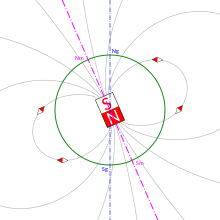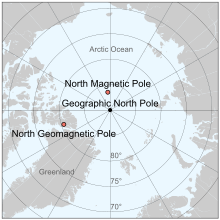Geomagnetic pole


Thegeomagnetic polesareantipodal pointswhere the axis of a best-fittingdipoleintersectsthe surface ofEarth.Thistheoreticaldipole is equivalent to a powerful barmagnetat thecenter of Earth,and comes closer than any other point dipole model to describing themagnetic fieldobserved at Earth's surface. In contrast, themagnetic polesof the actual Earth are notantipodal;that is, the line on which they lie does not pass through Earth's center.
Owing to motion of fluid in the Earth'souter core,the actual magnetic poles are constantly moving (secular variation). However, over thousands of years, their direction averages to the Earth's rotation axis. On the order of once every half a million years, thepoles reverse(i.e., north switches place with south) although the time frame of this switching can be anywhere from every 10 thousand years to every 50 million years.[2]The poles also swing in an oval of around 50 miles (80 km) in diameter daily due tosolar winddeflecting the magnetic field.[3]
Although the geomagnetic pole is only theoretical and cannot be located directly, it arguably is of more practical relevance than the magnetic (dip) pole. This is because the poles describe a great deal about the Earth's magnetic field, determining for example whereaurorascan be observed. Thedipole model of the Earth's magnetic fieldconsists of the location of geomagnetic poles and the dipole moment, which describes the strength of the field.[3]
| Year | 1990 (definitive) | 2000 (definitive) | 2010 (definitive) | 2020 |
|---|---|---|---|---|
| North geomagnetic pole | 79°12′N71°06′W/ 79.2°N 71.1°W | 79°36′N71°36′W/ 79.6°N 71.6°W | 80°06′N72°12′W/ 80.1°N 72.2°W | 80°42′N72°42′W/ 80.7°N 72.7°W |
| South geomagnetic pole | 79°12′S108°54′E/ 79.2°S 108.9°E | 79°36′S108°24′E/ 79.6°S 108.4°E | 80°06′S107°48′E/ 80.1°S 107.8°E | 80°42′S107°18′E/ 80.7°S 107.3°E |
| Magnetic dipole moment |
7.84 | 7.79 | 7.75 | 7.71 |
Definition[edit]
As afirst-order approximation,theEarth's magnetic fieldcan be modeled as a simpledipole(like a bar magnet), tilted about 9.6° with respect to theEarth's rotationaxis (which defines theGeographic NorthandGeographic South Poles) and centered at the Earth's center.[5]The North and South Geomagnetic Poles are theantipodal pointswhere the axis of this theoretical dipole intersects the Earth's surface. Thus, unlike theactualmagnetic poles, the geomagnetic poles always have an equal degree of latitude andsupplementarydegrees of longitude respectively (2017: Lat. 80.5°N, 80.5°S; Long. 72.8°W, 107.2°E).[4]If the Earth's magnetic field were a perfect dipole, thefield lineswould be vertical to the surface at the Geomagnetic Poles, and they would align with theNorthandSouthmagnetic poles, with the North Magnetic Pole at the south end of dipole. However, the approximation is imperfect, and so the Magnetic and Geomagnetic Poles lie some distance apart.[6]
Location[edit]
Like theNorth Magnetic Pole,the North Geomagnetic Pole attracts the north pole of a barmagnetand so is in a physical sense actually a magneticsouthpole. It is the center of the 'open' magnetic field lines which connect to theinterplanetary magnetic fieldand provide a direct route for thesolar windto reach theionosphere.As of 2020[update],it was located at80°39′N72°41′W/ 80.65°N 72.68°W,[7]onEllesmere Island,Nunavut,Canada,compared to 2015, when it was located at80°22′N72°37′W/ 80.37°N 72.62°W,also on Ellesmere Island.[5]
The South Geomagnetic Pole is the point where the axis of this best-fitting tilted dipole intersects the Earth's surface in the southern hemisphere. As of 2020[update],it is located at80°39′S107°19′E/ 80.65°S 107.32°E,[7]whereas in 2005, it was calculated to be located at79°44′S108°13′E/ 79.74°S 108.22°E,nearVostok Station.
Because the Earth's actual magnetic field is not an exact dipole, the (calculated) North and South Geomagnetic Poles do not coincide with the North and South Magnetic Poles. If the Earth's magnetic fields were exactly dipolar, the north pole of a magneticcompassneedle would point directly at the North Geomagnetic Pole. In practice, it does not because the geomagnetic field that originates in the core has a more complex non-dipolar part, andmagnetic anomaliesin theEarth's crustalso contribute to the local field.[5]
The locations of geomagnetic poles are calculated by a statistical fit to measurements of the Earth's field by satellites and in geomagnetic observatories. This can be theInternational Geomagnetic Reference Field(covering a wide time-span in history)[8]or the U.S.World Magnetic Model(only covering a five-year period).
Movement[edit]
The geomagnetic poles move over time because the geomagnetic field is produced by motion of the molten iron alloys in the Earth'souter core.(Seegeodynamo.) Over the past 150 years, the poles have moved westward at a rate of 0.05° to 0.1° per year and closer to the true poles at 0.01° per year.[6]
Over several thousand years, the average location of the geomagnetic poles coincides with the geographical poles.Paleomagnetistshave long relied on thegeocentric axial dipole (GAD) hypothesis,which states that — aside from during geomagnetic reversals — the time-averaged position of the geomagnetic poles has always coincided with the geographic poles. There is considerable paleomagnetic evidence supporting this hypothesis.[9]
Geomagnetic reversal[edit]
Over the life of the Earth, the orientation of Earth's magnetic field has reversed many times, with geomagnetic north becoming geomagnetic south and vice versa – an event known as ageomagnetic reversal.Evidence of geomagnetic reversals can be seen atmid-ocean ridgeswheretectonic platesmove apart. Asmagmaseeps out of themantleand solidifies to become new ocean floor, the magnetic minerals in it are magnetized in the direction of the magnetic field. The study of thisremanenceis calledpalaeomagnetism.Thus, starting at the most recently formed ocean floor, one can read out the direction of the magnetic field in previous times as one moves farther away to older ocean floor.
See also[edit]
Notes[edit]
- ^"Magnetic North, Geomagnetic and Magnetic Poles".wdc.kugi.kyoto-u.ac.jp.Retrieved2019-12-18.
- ^"Is it true that Earth's magnetic field occasionally reverses its polarity?".www.usgs.gov.Retrieved2021-09-16.
- ^abNair, Manoj C."Wandering of the Geomagnetic Poles | NCEI".www.ngdc.noaa.gov.
- ^ab"Magnetic North: Geomagnetic and Magnetic Poles".World Data Center for Geomagnetism. Kyoto, Japan: Kyoto University.Retrieved11 June2018.
- ^abc"Geomagnetism Frequently Asked Questions".National Geophysical Data Center.Retrieved1 June2016.
- ^abMerrill, McElhinny & McFadden 1996,Chapter 2
- ^ab"World Magnetic Model - Model Limitations".www.ngdc.noaa.gov.Retrieved2020-01-17.
- ^IAGA Division V Working Group V-MOD."International Geomagnetic Reference Field".Retrieved20 December2016.
- ^Merrill, McElhinny & McFadden 1996,Chapter 6
References[edit]
- McElhinny, Michael W.; McFadden, Phillip L. (2000).Paleomagnetism: Continents and Oceans.Academic Press.ISBN0-12-483355-1.
- Merrill, Ronald T. (2010).Our Magnetic Earth: The Science of Geomagnetism.University of Chicago Press.ISBN978-0-226-52050-6.
- Merrill, Ronald T.; McElhinny, Michael W.; McFadden, Phillip L. (1996).The magnetic field of the earth: Paleomagnetism, the core, and the deep mantle.Academic Press.ISBN978-0-12-491246-5.
